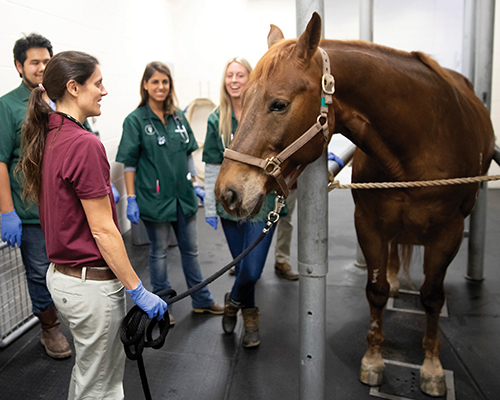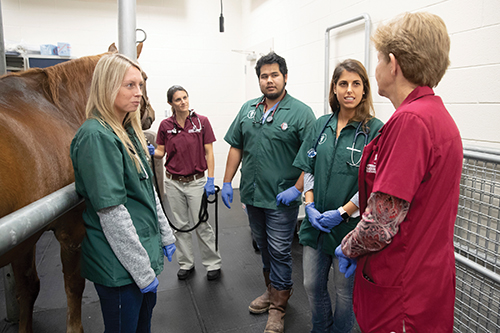From the Horse’s Mouth
When Dr. Michelle Coleman isn’t teaching and collaborating with students, she is devoted to her research, which examines the effects of equine obesity and a condition that affects the larynx.
Story by Briley Lambert
As a young girl in Greenville, South Carolina, Dr. Michelle Coleman was always fascinated with the beauty and grace of the horse.

Her longtime desire to one day enter the medical profession was reinforced by an infatuation with the science behind equine medicine, which would spark a lifetime of intrigue and years of research in the field of veterinary medicine.
After graduating from veterinary school at the University of Georgia and completing an internship in Lexington, Kentucky, Coleman came to the Texas A&M College of Veterinary Medicine & Biomedical Sciences (CVM) for a residency in large animal internal medicine. She has now been with the Large Animal Hospital (LAH) in the CVM for 10 years.
While here, she also completed a Ph.D. in biomedical sciences.
Her knowledge in equine medicine has been put to great use at the CVM.
With the equine industry in Texas ranking among the largest in the country—consisting primarily of working horses and those owned as pets—Coleman and the rest of the equine team at the CVM stay busy year-round.
In addition, Coleman has focused her research on laminitis, a condition affecting the foot of the horse.
Her studies, mentored by Dr. Noah Cohen, have found that obesity is a risk factor for the development of laminitis; thus, she has focused her attention on better understanding the physiological processes associated with obesity to improve the mechanisms for preventing or managing obesity and, ultimately, reduce the burden of laminitis.
“What we know about obesity in people is that it is not just about what we eat and how much we exercise; it’s certainly important, but it is not the whole picture,” she said. “Better understanding the mechanisms of obesity will improve our ability to manage or prevent it. Our primary interests are in the role of the gastrointestinal tract and gut microbiota in the development of obesity.”

Another area of interest for Coleman is nasopharyngeal cicatrix, a devastating equine condition that causes scarring and often life-threatening constriction in the upper respiratory tract.
Although epidemiological data are lacking, clinical experience indicates that this disease is highly prevalent in central and southeast Texas and is the most common disorder of the upper respiratory tract evaluated at the LAH, according to Coleman.
Despite the awareness of this condition since the early 1970s and the high morbidity rates in Texas, the cause of this devastating condition remains unknown, making the research even more intriguing for Coleman.
Outside of her research projects, Coleman enjoys working alongside and collaborating with veterinary students at the CVM.
“It is amazing to be around veterinary interns, residents, and students,” she said. “Their questions are engaging and stimulating.”
Despite her focus on research, Coleman said teaching has become one of her favorite aspects of working here.
“Having students around keeps us honest, and it keeps us fresh and enthusiastic about what we’re doing,” she said.
When she isn’t breaking new ground in the world of equine medicine, Coleman enjoys spending time with her husband—Dr. Canaan Whitfield, an assistant professor of large animal surgery—as well as their two children and their family pet—a miniature pony.
With her 3- and 6-year-old children and a veterinary school full of eager-to-learn students, Coleman said she looks forward to working with the CVM to shape the future of veterinary medicine.
“We are dedicated to producing excellent veterinarians; beyond the knowledge of veterinary medicine, they must develop solid communication skills and a passion for the profession,” she said.
###
Note: This story originally appeared in the 2019 Spring edition of CVM Today.
For more information about the Texas A&M College of Veterinary Medicine & Biomedical Sciences, please visit our website at vetmed.tamu.edu or join us on Facebook, Instagram, and Twitter.
Contact Information: Jennifer Gauntt, Interim Director of Communications, Media & Public Relations, Texas A&M College of Veterinary Medicine & Biomedical Science; jgauntt@cvm.tamu.edu; 979-862-4216


